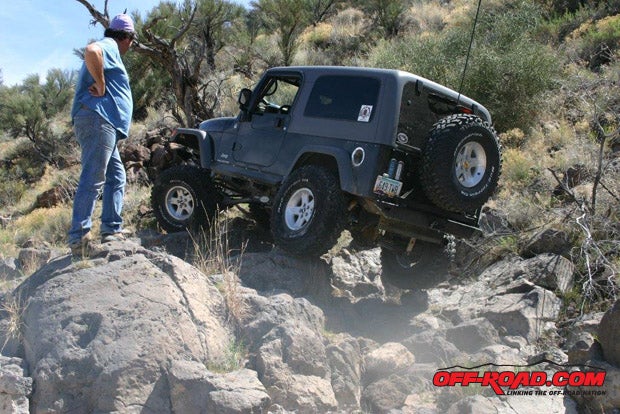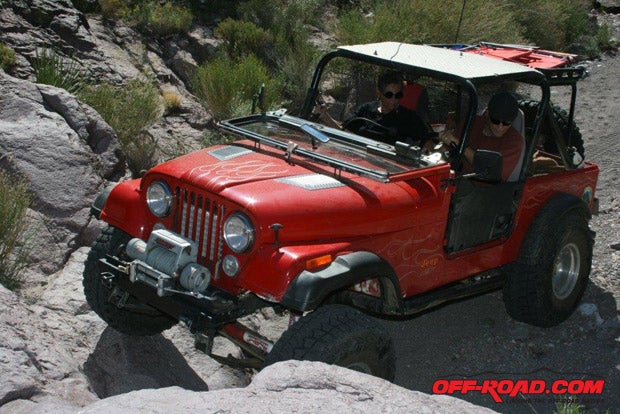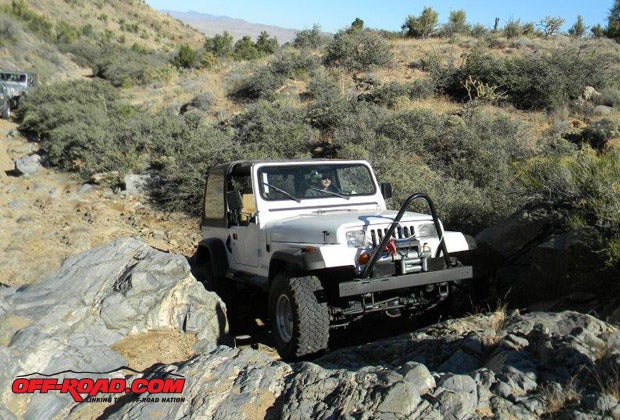Previous Jeep Creep Columns
May 2014
Jeep recalls from NHTSA this month:
14V-154: Chrysler is recalling certain model year 2011-2014 Jeep Grand Cherokee and Dodge Durango vehicles manufactured from January 5, 2010, through September 8, 2013. The subject vehicles have a brake booster with a center shell that may corrode and allow water to get inside. The water inside could freeze and limit the braking ability of the vehicle, increasing the risk of a crash. Chrysler will notify owners, and dealers will add a water diverter shield to the booster after the booster has been tested to confirm it can hold an acceptable amount of vacuum pressure. If the booster inspection confirms an unacceptable loss of vacuum pressure, the booster will be replaced. Repairs will be made free of charge. Owners may contact Chrysler at 800-853-1403. Chryslerís recall campaign number is P14.![]()
Gas Cap
My 2007 JK Unlimited keeps giving me a warning note on the dashboard of ďgas cap.Ē I canít figure out what it means. Iíve removed my original gas cap (itís unlocked with the ignition key) and then made sure itís secure on the filler neck. Iíve examined the gasket and it seems OK. And Iíve checked the filler hoses for leaks and couldnít find any, nor could I smell any gas while on the trail, even with a full tank. Whatís going on? Iíve checked on buying a new keyed cap from my local Jeep dealership and itís way too expensive. I hate to give up the original keyed cap because of where I workóitís just so convenientówith an aftermarket lockable gas cap from an auto parts store. What else can I do?
Jack Clinton
Inglewood, CA
This happens over here in Arizona more often than I imagine it does in California because of the heat and lack of humidity, and itís happened to me twice. Rejuvenate the capís gasket with grease. Rub the grease into the gasket with a finger, which will make the gasket more pliable (kind of like applying moisturizer to your skin in the desert). Place the cap back on the filler neck, make sure itís secure, and see if the dash warning comes up againóit shouldnít. If the warning returns in a week or so, reapply the grease. It may take a few applications but eventually the capís gasket will eventually remain pliable a keep a good seal.

Rubicrawler
I really love my í06 Rubicon Unlimited, on road and off road it performs great! However, Iím thinking of changing differential gears to improve its trail worthiness. The problem is, I live in Southern California, which means I have to drive the freeways for hours before I can hit the dirt. If I go too low itís going to cost me time (Iíll have to drive slower) and gas, but if I donít go low enough it wonít help me in the dirt. What do you suggest?
Megan Tripp
El Cajon, CA
Megan, Advance Adapters introduced a product a few years ago that should solve your problem easily and fairly cheaplyóthe Rubicrawler. It is mounted between your transmission and transfer case and does not affect highway or high-range performance whatsoever. However, it gives you a second low range, which can be used in either two-wheel or four-wheel drive. Whatís the advantage of a 2WD low range? Think launching a boat. You shift the Rubicrawler to its 2.72:1 low range in two-wheel drive and you have the power to easily control the Jeep and boat combination on a steep launching ramp without having to worry about being in four-wheel drive on a hard surface, which could break things. While wheeling you can either use your Rubiconís 4:1 low range or the Rubicrawlerís 2.72:1 medium low range (for less aggressive hills), or use both low ranges for a super low gearing. With the Rubicrawler in low range and the transfer case in four-wheel-drive low range, the final gear ratio with the transmission in any gear is reduced 10.88 times lower. This feature gives you power to all four wheels. This is an extreme crawl ratio that provides a slow, controlled approach to an obstacle. All of this means, Megan, you donít have to change your differential gears for increased off-road capability.
Water Flow Restrictor
My 1984 CJ7 has a Chevy V8, GM TH350 automatic and 4.56:1 gears in it. It runs great on the trails around here in New Mexico, but it tends to overheat on the freeway (doesnít overheat on the trails). And as soon as it starts to overheat it also begins to ping on hills. I have a 180 thermostat, an aluminum radiator, and twin electric fans, and a separate transmission cooler. I canít figure out what else to do.
Doug Eastman
Farmington, NM
I had to call a few friends on this question, Doug, as it has never happened to me and I needed some help. The consensus of opinion is that your coolant is flowing too rapidly through the radiator, which doesnít allow it to cool sufficiently, so the heat slowly builds up when youíre at freeway speeds. If you can slow the flow, you should be OK. Order a Moroso Water Outlet Restrictor kit PN 63440 from Summit Racing. The restrictor (you get three different sizes in the kit), which looks like a washer, goes in place of the thermostat. Try the ½-inch diameter restrictor first, test it on the highway, and if need be go up one size at a time.
Wonky Wobble
Iíve got a few miles on my í07 Unlimited now (about 60,000 miles), and under the right road conditions the front end gets a wonky wobble. I have to slam on the brakes and pull to the side of the road. So far itís only happened on city streets and it hasnít occurred on the freeway, but Iím constantly on edge worrying about the steering wheel going wild unexpectedly. I think it only happens after Iíve had it out on a rocky trail but I donít swear to it. I put a short-arm lift kit on it shortly after buying it nearly eight years ago. Could that be causing it? What should I do?
Sean Levine
Amarillo, TX
Thereís a whole raft of things that could be wrong with your JK, Sean. First two things to do are: make sure the tires are properly balanced and the front end is correctly aligned (make sure the caster is correct). Once those two things are taken care of, have the tech check for front end sideways movement when you turn the steering wheel back and forth. If your rubber or neoprene suspension bushings are worn or dried out, they could be allowing the axles to move back and forth when youíre steering. Or the various attachment points for the suspension components could be loose, or it could be a combination of worn bushings and loose components. If the components are loose, tighten them to specifications, including the tie rod ends. If the bushings are overly worn, replace them and then tighten everything to specs.

Squeaky Fan Belt
Steve Mains
Cheyenne, WY
The intermittent problems are always harder to diagnose because itís so hard to make it happen while youíre looking for it. Itís frustrating! However, since Iíve been wheeling in the Southwestern deserts for most of my Jeeping life, this problem is easy to figure out and fix. Itís a bit of a combination of occurrences. First, your fan belt is becoming worn but itís still working, so that when youíre driving the dusty backroads in Wyoming, the dust is causing it to squeak. When youíre back on the macadam, thereís no dust and no squeak. Replace your fan belt and then tape or tie wrap your old fan belt to your YJís grille bracing rod. I can guarantee that youíll never snap a fan belt while youíre in your driveway, but you never know when a fan belt could break in the backcountry, and a broken fan belt puts you on the trailer almost immediately! Make sure you also include the necessary tools to change the belt in your trail toolbox.
Soap
One of the ďold troopsĒ in my club told me that if I carry a bar of soap in my toolbox I can use it to seal a gas tank leak. He said it has to be real soap and not some perfumed ďgirlieĒ soap. Is this true, or is he pulling my leg on a trailside ďsnipe huntĒ? It sounds like a story to me.
Brittany Wells
Des Moines, Iowa
Like you, Brittany, I thought it was an old ďtrail taleĒ when I first heard it back in the Ď60s, but itís true. Back then almost any bar of soap would work, but today with all the designer soaps there are only a few that Iím sure of. Lava, which is always great to have in your toolbox for after-repair cleanup, and Fels-Naptha Laundry Bar Soap, a laundry soap that I remember my grandmother slicing into her washing machine. I like the Fels-Naptha because I keep it in my center console and keeps everything in there smelling clean and fresh. But I also keep Lava in my toolbox, wrapped in a clean shop towel.
Which Winch?
Iíve been out in the woods four-wheeling by myself several times and Iíve been stuck in the mud a few times. A few times I was able to get out myself; a few other times I had to wait until another Jeep came wandering by. I donít want to quit solo wheeling and I donít want to wait for a friendly Jeeper if I get stuck again. Iíve been looking at mounting a winch. What brand should I buy? What pull rating should I get? I have an í05 Rubicon with a 3-inch lift and 33-inch Goodyear MT/R tires.
Max McCarthy
Issaquah, WN
I canít recommend a specific brand, Max, because just about all of them are pretty much equal (Iíve owned at least one of all the major brands over the yearsóplus a factory PTO winch on a í64 Toyota FJ45). Mile Marker makes a hydraulic winch that runs off the power steering pump, plus some electric models. I happen to prefer an electric winch because if you ever should find your engine under water, an electric winch can still pull you out if the battery lasts long enough. Just look at each winchís design, check its reputation on a few Internet forums, and decide on the one you like the best. A rule of thumb for winches is to buy one thatís rated at least twice what the vehicle weighs. So if your Jeep weighs 4,000 pounds, buy a winch rated at 8,000 pounds (there are also several 9,000-pound rated winches if you donít mind the extra dollars). When you choose the winch, I highly recommend you have the steel rope replaced with synthetic rope. Itís lighter, easier to use in the field, and itís safer (it doesnít react with dangerous results if it breaks; it simply falls to the ground). Also be sure to pick up an accessory kit from the same manufacturer, especially if you continue to wheel alone. Accessory kits usually contain gloves, clevis, tree strap, and a snatch block (and you may want to add another clevis and snatch block). Snatch blocks can double the winchís pull (by snatching off an anchor back to the Jeep) or change the ropeís direction.
As usual, each month, Iím shouting out a huge THANK YOU to Paul Schupp at Rock Lizard 4x4 in Kingman, Arizona, for his invaluable assistance in answering many of the Jeep Creep questions. Send your Jeep questions to editor@off-road.com, Attn: Jeep Creep.
Previous Jeep Creep Columns
May 2014


 Your Privacy Choices
Your Privacy Choices